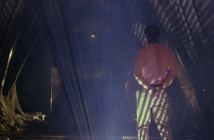Editor’s Notes: The following review is part of our coverage for TIFF’s Dreaming in Technicolor. For more information on this TIFF film series visit http://tiff.net and follow TIFF on Twitter at @TIFF_NET.
Directed by the inimitable classical Hollywood filmmaker, Douglas Sirk, and shot by famed cinematographer Russell Metty, All That Heaven Allows displays much of what there is to love about the so called Golden era: affable characters, striking painterly colours provided by Technicolor, and an inspiring tale of love and tragedy. Ultimately, it is a story of love under the pressures of societal expectations; in Dostoyevskian fashion, the protagonist, Cary Scott (Jane Wyman), denies her desires only to discover the pointlessness of doing so. Her tragic mistake visually scribed by her reflection in a television screen, the film uses primarily visual means to convey the emotional developments in her journey to self-love and self-truth.
This conflict, which is frankly rather predictable in the classic Hollywood fashion, is made significantly more substantial through Metty’s careful direction, an emotive score, and the thematically structured mise-en-scene.
The worry of social pressures, family expectations, and reputation figure into the plot, in which a widow falls for a younger man who stands in direct opposition to social norms. He is a blue collar worker in a lumberjack shirt who works with his hands and listens only to the voice inside himself. Portrayed by Rock Hudson, Ron Kirby is the classic Hollywood hunk and hero, the man of any woman’s dreams. Young and of lower class, much gossip and viciousness, even from her own children, surmount when word gets out that they are romantically involved. While her heart beats for him, her indoctrinated beliefs and social upbringing prevents her from fully embracing their wonderful, albeit unconventional, love. The fight between heart and mind rages until the bitter end.
This conflict, which is frankly rather predictable in the classic Hollywood fashion, is made significantly more substantial through Metty’s careful direction, an emotive score, and the thematically structured mise-en-scene. With a typically mobile camera, Metty, known for choreographing the famous long take at the beginning of Orson Welle’s Touch of Evil, dazzles viewers with cinematographic intent, including most significantly a few crane movements and slow tracking shots bursting with emotion. For example, a slow track towards a frosted window in which one can see Jane’s tears roll down her soft cheeks conveys through camera movement the intensity of her sadness.
The upbeat music and devastating mise-en-scene build a greatly artistic image rife with emotional intensity. Music throughout the film, in fact, conveys the conflict between love and tragedy.
This sadness is ever-more accentuated by a musical contrast. Young boys on a sleigh ride sing Joy to the World during this scene. The upbeat music and devastating mise-en-scene build a greatly artistic image rife with emotional intensity. Music throughout the film, in fact, conveys the conflict between love and tragedy. It alters between euphoric tenor and cacophonic bass during scenes of psychological struggle. Most effectively, a musical motif from Franz Liszt is used to convey the triumph of life. It is used three times: first when Jane adores the golden tree Ron gifts her, second when they first kiss, and third when he asks her to marry him. Echoing the development of their relationship, each refrain of this melody is at once new and filled with nostalgic history to when it was first heard. A reprisal of the melody thus enhances one’s association built in regards to their love and togetherness, making their love ever-more strongly conveyed.
Being “true to thine self” is of religious importance in All That Heaven Allows. The freedom that comes from not only embracing who you are but actively living who you are is embodied by Ron’s personality and given to Jane in the form of his love. To accept Ron’s love is thus a challenge for Jane’s inner plight of self-revelation. Captured and echoed in the symbolic face of an on-looking deer, God’s will, emphasized by nature, seeks only truth, and most importantly truth of self. Jane must learn this important lesson before it is too late.
Directed by the inimitable classical Hollywood filmmaker, Douglas Sirk, and shot by famed cinematographer Russell Metty, All That Heaven Allows displays much of what there is to love about the so called Golden era: affable characters, striking painterly colours provided by Technicolor, and an inspiring tale of love and tragedy.




